Le Grand Macabre, LSO, Rattle, Barbican | reviews, news & interviews
Le Grand Macabre, LSO, Rattle, Barbican
Le Grand Macabre, LSO, Rattle, Barbican
Demi-staging of Ligeti's apocalypse-maybe hits hard but misses the wit and brio
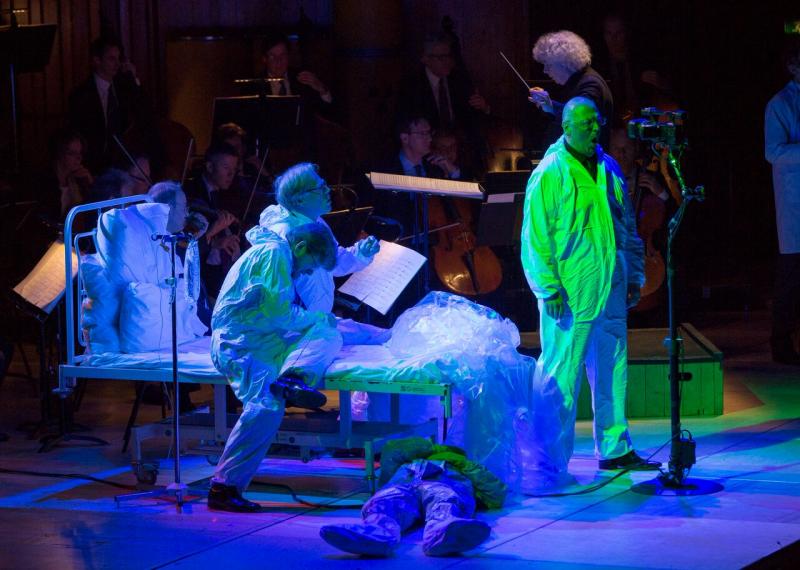
The Big Mac – as in Ligeti's music-theatre fantasia on the possible death of Death – is here to stay. Back in 1990, three critics (I was one) were invited on to the BBC World Service to say which work from the previous decade we thought would survive.
Sellars (pictured below with Rattle at the final rehearsal) has been part of Le grand macabre's performing history. He presided over the 1997 Salzburg staging, for which Ligeti cut and reshaped the score to make it less talky and more sung-through; this version should have reached the Royal Opera, but the house's grand reopening couldn't cope with the production's mechanics so we didn't see it then. The Californian maverick writes beautifully in the programme about the work's "hilarity and fun" in its playful approach to the serious subject of Death arriving to sort out the decadent inhabitants of "Brueghelland" (the source is a 1934 play by the Belgian Michel de Ghelderode). But in his latest attempt to shoehorn the riotous "flea market", as Ligeti described it, into a rigid commentary on nuclear disaster, Sellars manages to sit on nearly all the "hilarity and fun".
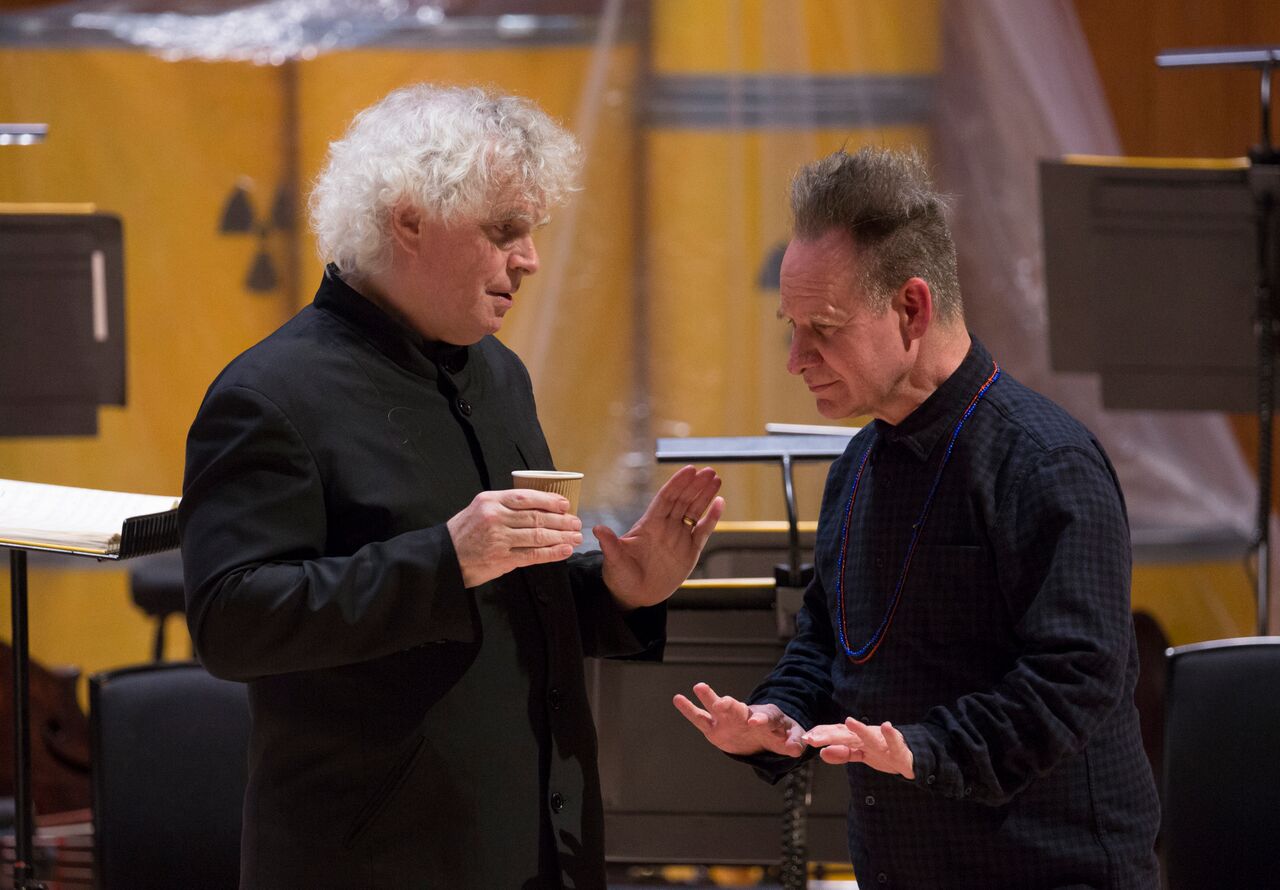 So while we puzzle out what's going on with the folk in white coats, starting out at a Nuclear Energy seminar and clearly, some of them, suffering from radiation, true meaning and gesture should be found in the London Symphony Orchestra under Rattle. They do indeed run the full gamut of Ligeti's sound cornucopia, from the familiar chord-clusters to the florid polyphonies (I've never noticed, for instance, the crowings of Rameau's hen – brilliantly taken by piccolo clarinettist Chi-Yu Mo – as strings revolve a Bourée perpetuelle to which Nekrotzar screws the jaded, sado-masochistic Astrologer's wife Mescalina to death (pictured below, Heidi Melton dragged along by Frode Olsen and Peter Hoare).
So while we puzzle out what's going on with the folk in white coats, starting out at a Nuclear Energy seminar and clearly, some of them, suffering from radiation, true meaning and gesture should be found in the London Symphony Orchestra under Rattle. They do indeed run the full gamut of Ligeti's sound cornucopia, from the familiar chord-clusters to the florid polyphonies (I've never noticed, for instance, the crowings of Rameau's hen – brilliantly taken by piccolo clarinettist Chi-Yu Mo – as strings revolve a Bourée perpetuelle to which Nekrotzar screws the jaded, sado-masochistic Astrologer's wife Mescalina to death (pictured below, Heidi Melton dragged along by Frode Olsen and Peter Hoare).
This long second scene, though, needs the scherzoid touch Esa-Pekka Salonen brought to it in Salzburg – an excellent live recording exists, where the audience laughs a lot more than they did last night – if it is not to seem too diversionary for too long. Rattle was simply too heavy here, for all the loud brilliance of his players.
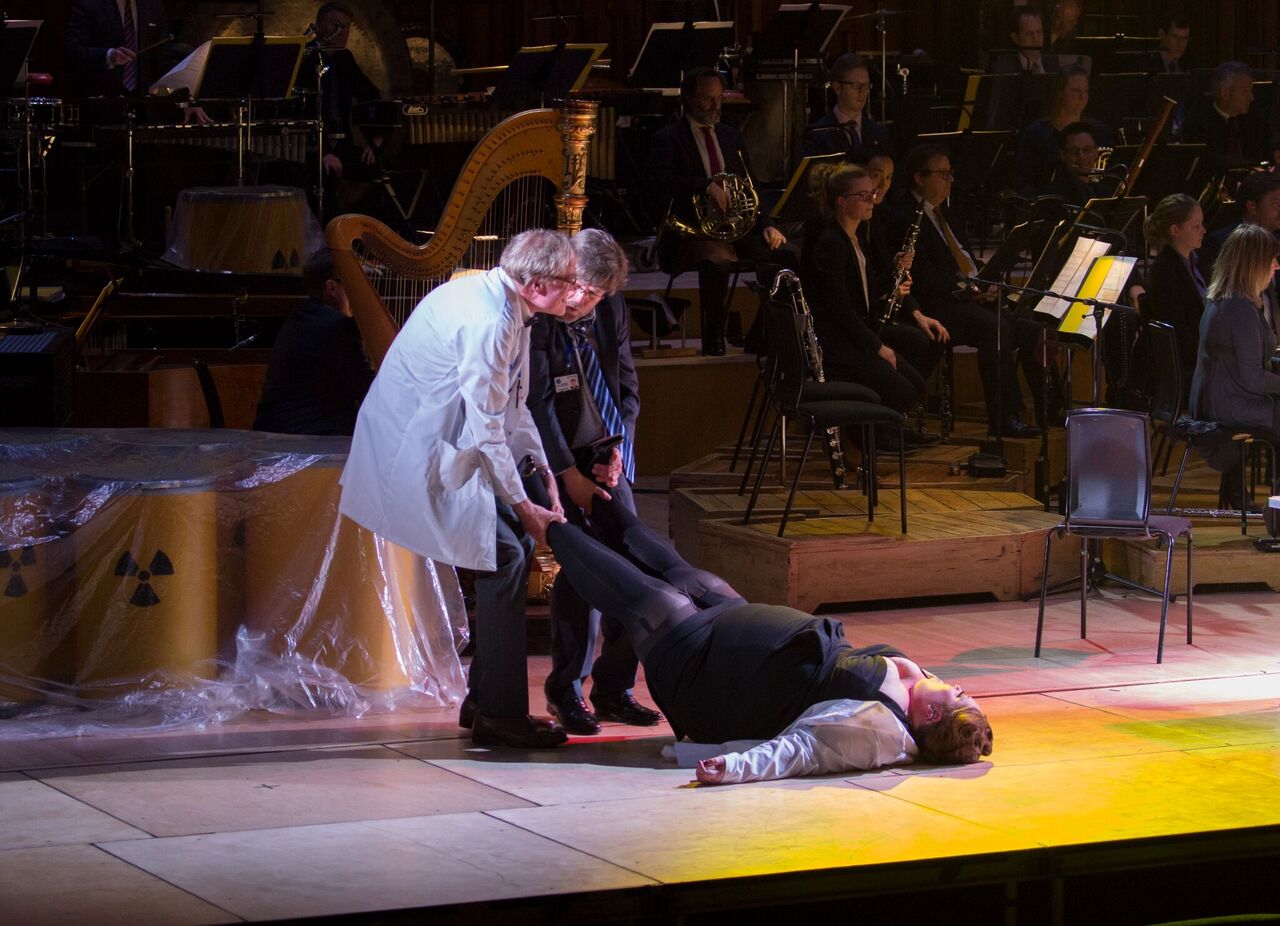 Ideally the first and second acts should be run together if the spectators are not to come out in the interval wondering what it's all going to add up to. Both Ligeti and Rattle rise to the Great Day (or Midnight) of Destruction, director and conductor between them making full use of Barbican spaces for the big rattle-bag processional that unfolds against a ground-bass distortion of the pizzicato theme in Beethoven's Eroica finale. The apocalyptic trumpet fanfares are searingly brilliant, the LSO Chorus makes its mark as a revolting populace in the aisles of the stalls, and the final passacaglia – did everyone die or not? – tugs oddly at the heartstrings.
Ideally the first and second acts should be run together if the spectators are not to come out in the interval wondering what it's all going to add up to. Both Ligeti and Rattle rise to the Great Day (or Midnight) of Destruction, director and conductor between them making full use of Barbican spaces for the big rattle-bag processional that unfolds against a ground-bass distortion of the pizzicato theme in Beethoven's Eroica finale. The apocalyptic trumpet fanfares are searingly brilliant, the LSO Chorus makes its mark as a revolting populace in the aisles of the stalls, and the final passacaglia – did everyone die or not? – tugs oddly at the heartstrings.
The singing runs the gamut from good to terrific. Weak link, perhaps, is the Nekrotzar of Pavlo Hunka; he doesn't have the effortless authority of the Salzburg production's Willard White (who, when I interviewed him before the Royal Opera production that didn't happen, turned out not to have a clue about what was happening overall). But he rises to Death's attempt to wield his scythe and bring the world to an end – brought low himself by booze – with all his might. No qualms about Peter Hoare's clarion Piet the Pot, though this great singer-actor isn't allowed to be very funny, presented not as a devil-may-care toper but a conferencier on the verge of vomiting.
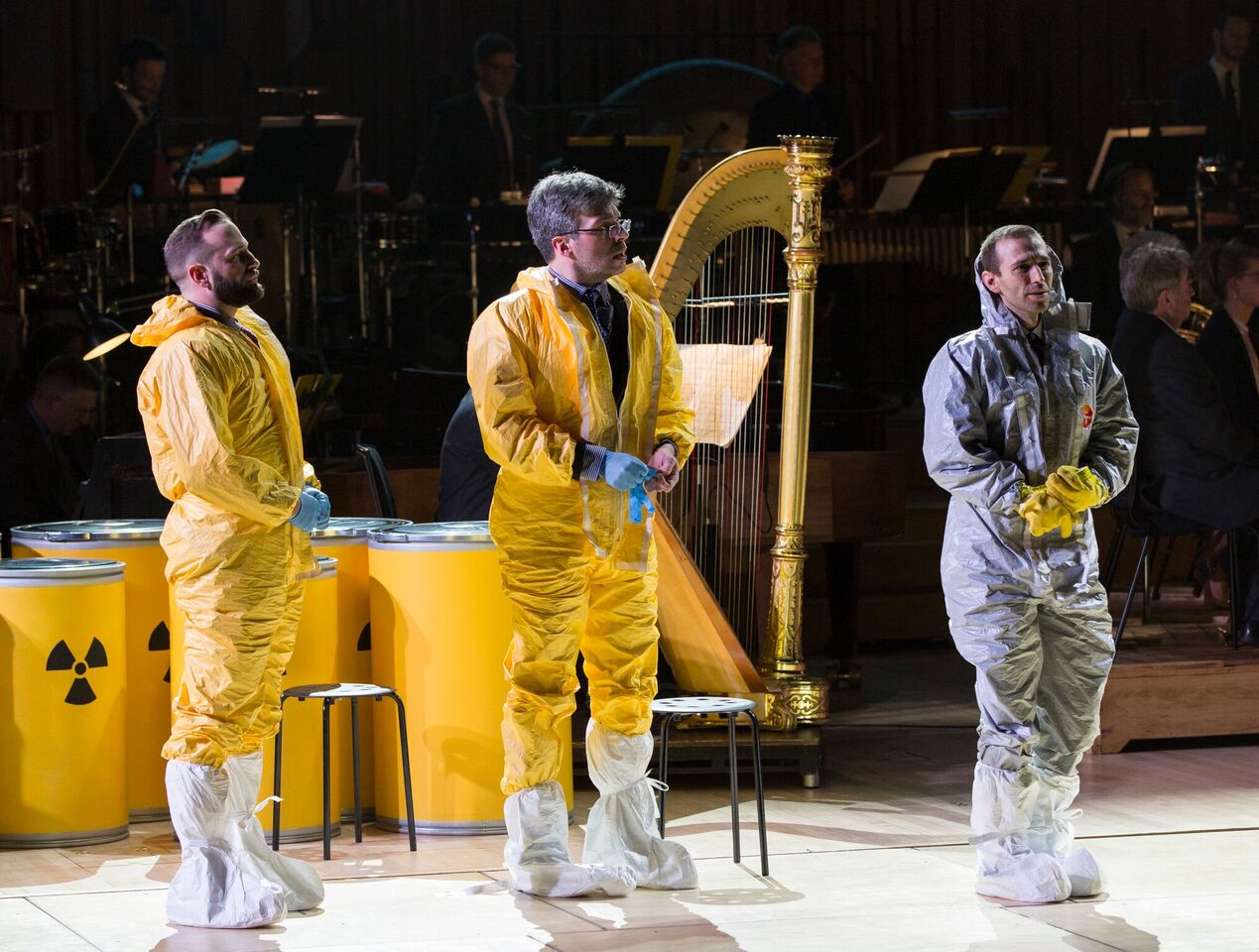
Never, surely, have the androgynous lovers Amanda and Amando been more strikingly sung than they are here, Elizabeth Watts's restrained radiance matched by the contralto low notes of the stunning Ronnita Miller. Sellars has the rather good idea of running a film (by Nick Hillel) of flowers flaunting their stamens to be pollinated against their love ecstasies; nature, as initially represented by cows in a field beyond a nuclear plant, will triumph, though there's no suggestion of the libretto's lovers embracing in that fine and private place, a tomb. The savage sex play of henpecked Astradamors (Frode Olsen, who, like Hunka, could be more basso profundo-ish) and Mescalina loses its foul-mouthed edge when conducted, presumably, by Skype on laptops, but it's a luxury to have a dramatic soprano in a mezzo role. How deliciously low has the game Heidi Melton sunk from singing the virginal Elisabeth in Tannhäuser and the all-for-love Isolde.
More defused still are the brutal games of the palace ministers and ineffectual Prince Go-Go in Act Two. Being originally stipulated as a petulant, fat child,Go-Go would most obviously be portrayed now as the all-too-likely soon-to-be American President. But countertenor Anthony Roth Costanzo (pictured above, right, with Joshua Bloom and Peter Tantsits) gives him luminous pathos; I was actually moved by his sad little "hello"s as he emerges from the failed apocalypse, partly because it's one of the few places where Ligeti lets the score be simple – there's nothing but a double-bass line beneath the high voice. Sellars' one good substitution, albeit one that doesn't allow for Ligeti's surrealism, is to transform the exotic-bird Chief of Police into a dying radiation victim; the brilliant coloratura Audrey Luna (pictured below) goes to the edge with the horror.
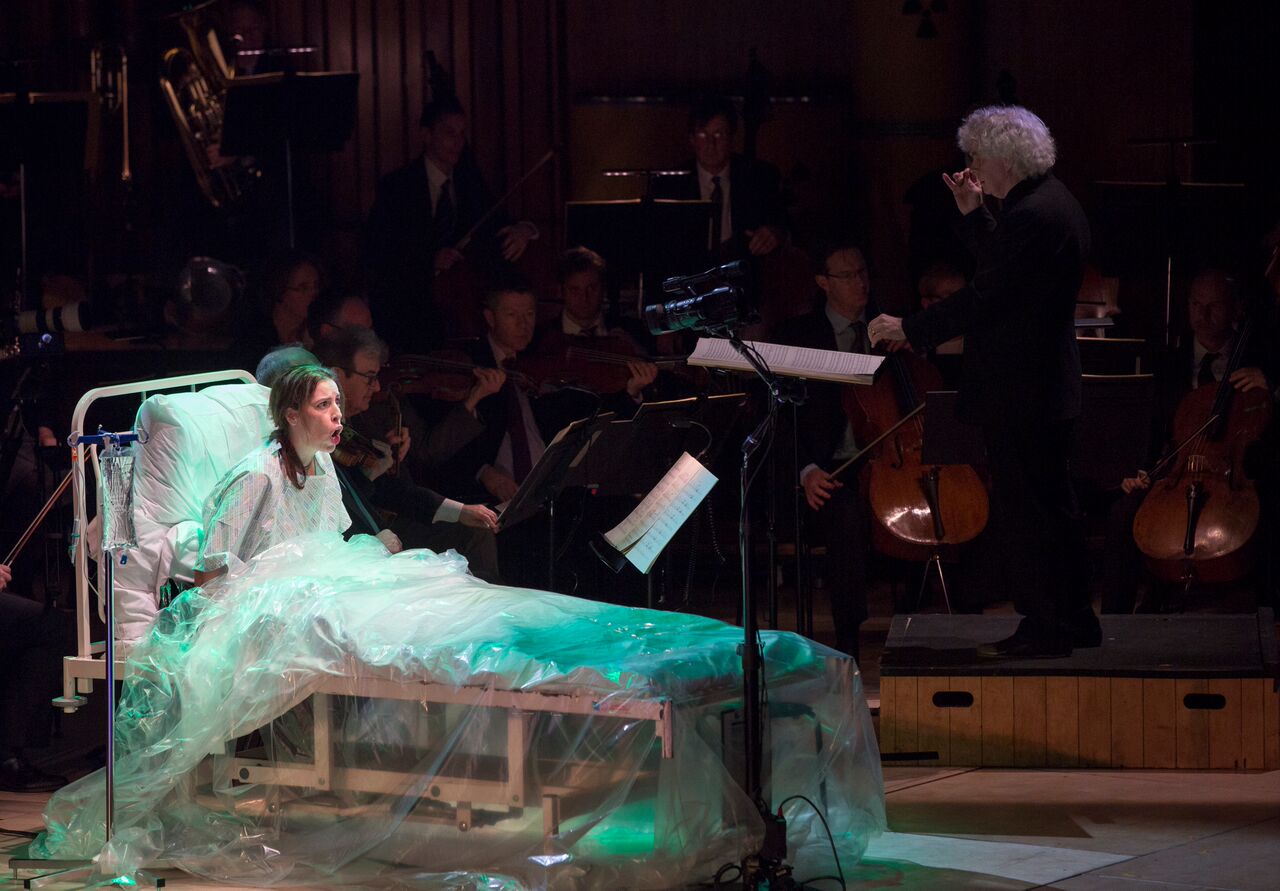 Throughout all this, though, Sellars' persistence in showing us the consequences of nuclear fall-out, not exactly synchronised on screen with the developing action, weakens the ever-blacker satire. At least that final ensemble, where sexual love seems to trump all, brings a searing pathos. Sellars has his cast collapse at the end; Ligeti suggests life goes on after all, and, as with most of his ignored stage directions, I prefer that. The best approach, surely, would be along the lines of Graham Vick's modern-life panorama in his unforgettable Birmingham Khovanskygate, but perhaps Sellars felt himself limited by the circumstances. Next time, it has to be all – preferably from Vick – or the kind of nothing that allows the audience free imaginative rein: in short, the kind of straight concert-hall line-up that worked so well for the Alice opera of Gerald Barry, Ligeti's true successor.
Throughout all this, though, Sellars' persistence in showing us the consequences of nuclear fall-out, not exactly synchronised on screen with the developing action, weakens the ever-blacker satire. At least that final ensemble, where sexual love seems to trump all, brings a searing pathos. Sellars has his cast collapse at the end; Ligeti suggests life goes on after all, and, as with most of his ignored stage directions, I prefer that. The best approach, surely, would be along the lines of Graham Vick's modern-life panorama in his unforgettable Birmingham Khovanskygate, but perhaps Sellars felt himself limited by the circumstances. Next time, it has to be all – preferably from Vick – or the kind of nothing that allows the audience free imaginative rein: in short, the kind of straight concert-hall line-up that worked so well for the Alice opera of Gerald Barry, Ligeti's true successor.
rating
Share this article
The future of Arts Journalism
You can stop theartsdesk.com closing!
We urgently need financing to survive. Our fundraising drive has thus far raised £33,000 but we need to reach £100,000 or we will be forced to close. Please contribute here: https://gofund.me/c3f6033d
And if you can forward this information to anyone who might assist, we’d be grateful.

Subscribe to theartsdesk.com
Thank you for continuing to read our work on theartsdesk.com. For unlimited access to every article in its entirety, including our archive of more than 15,000 pieces, we're asking for £5 per month or £40 per year. We feel it's a very good deal, and hope you do too.
To take a subscription now simply click here.
And if you're looking for that extra gift for a friend or family member, why not treat them to a theartsdesk.com gift subscription?
more Opera
 Help to give theartsdesk a future!
Support our GoFundMe appeal
Help to give theartsdesk a future!
Support our GoFundMe appeal
 Peter Grimes, Welsh National Opera review - febrile energy and rage
In every sense a tour de force
Peter Grimes, Welsh National Opera review - febrile energy and rage
In every sense a tour de force
 Owen Wingrave, RNCM, Manchester review - battle of a pacifist
Orpha Phelan brings on the big guns for Britten’s charge against war
Owen Wingrave, RNCM, Manchester review - battle of a pacifist
Orpha Phelan brings on the big guns for Britten’s charge against war
 Tales of Apollo and Hercules, London Handel Festival review - compelling elements, but a failed experiment
Conceptually the two cantatas just don't work together
Tales of Apollo and Hercules, London Handel Festival review - compelling elements, but a failed experiment
Conceptually the two cantatas just don't work together
 La finta giardiniera, The Mozartists, Cadogan Hall review - blooms in the wild garden
Mozart's rambling early opera can still smell sweet
La finta giardiniera, The Mozartists, Cadogan Hall review - blooms in the wild garden
Mozart's rambling early opera can still smell sweet
 Der fliegende Holländer, Irish National Opera review - sailing to nowhere
Plenty of strong singing and playing, but the staging is static or inept
Der fliegende Holländer, Irish National Opera review - sailing to nowhere
Plenty of strong singing and playing, but the staging is static or inept
 Die Zauberflöte, Royal Academy of Music review - first-rate youth makes for a moving experience
The production takes time to match Mozart's depths, but gets there halfway through
Die Zauberflöte, Royal Academy of Music review - first-rate youth makes for a moving experience
The production takes time to match Mozart's depths, but gets there halfway through
 Mansfield Park, Guildhall School review - fun when frothy, chugging in romantic entanglements
Jonathan Dove’s strip-cartoon Jane Austen works well as a showcase for students
Mansfield Park, Guildhall School review - fun when frothy, chugging in romantic entanglements
Jonathan Dove’s strip-cartoon Jane Austen works well as a showcase for students
 Uprising, Glyndebourne review - didactic community opera superbly performed
Jonathan Dove and April De Angelis go for the obvious, but this is still a rewarding project
Uprising, Glyndebourne review - didactic community opera superbly performed
Jonathan Dove and April De Angelis go for the obvious, but this is still a rewarding project
 Fledermaus, Irish National Opera review - sex, please, we're Viennese/American/Russian/Irish
Vivacious company makes the party buzz, does what it can around it
Fledermaus, Irish National Opera review - sex, please, we're Viennese/American/Russian/Irish
Vivacious company makes the party buzz, does what it can around it
 The Capulets and the Montagues, English Touring Opera review - the wise guys are singing like canaries
There's a bel canto feast when Bellini joins the Mob
The Capulets and the Montagues, English Touring Opera review - the wise guys are singing like canaries
There's a bel canto feast when Bellini joins the Mob
 Mary, Queen of Scots, English National Opera review - heroic effort for an overcooked history lesson
Heidi Stober delivers as beleaguered regent, but Thea Musgrave's opera is limiting
Mary, Queen of Scots, English National Opera review - heroic effort for an overcooked history lesson
Heidi Stober delivers as beleaguered regent, but Thea Musgrave's opera is limiting

Add comment